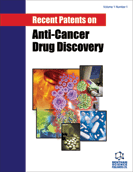
Abstract
Temozolomide (TMZ) is a monofunctional methylating agent which is spontaneously activated in aqueous solution into the dacarbazine metabolite 5-(3-methyl-1-triazeno)imidazole-4-carboxamide. This drug has been approved for the treatment of metastatic melanoma and glioblastoma multiforme, the latter in combination with radiotherapy. Furthermore, clinical trials have been performed to assess the activity of TMZ, alone or in combination, on brain metastatic solid tumors and leukaemias. This review will report clinical evidence on the use of TMZ for the treatment of different types of cancer; it also considers current knowledge on TMZs molecular mechanisms of action of and discusses relevant patents relating to the same drug.
Keywords: Anti-cancer drug, alkylating drug, DNA damage, temozolomide, triazenes
Recent Patents on Anti-Cancer Drug Discovery
Title: The Use of Temozolomide for the Treatment of Malignant Tumors: Clinical Evidence and Molecular Mechanisms of Action
Volume: 5 Issue: 3
Author(s): Roberto Bei, Laura Marzocchella and Mario Turriziani
Affiliation:
Keywords: Anti-cancer drug, alkylating drug, DNA damage, temozolomide, triazenes
Abstract: Temozolomide (TMZ) is a monofunctional methylating agent which is spontaneously activated in aqueous solution into the dacarbazine metabolite 5-(3-methyl-1-triazeno)imidazole-4-carboxamide. This drug has been approved for the treatment of metastatic melanoma and glioblastoma multiforme, the latter in combination with radiotherapy. Furthermore, clinical trials have been performed to assess the activity of TMZ, alone or in combination, on brain metastatic solid tumors and leukaemias. This review will report clinical evidence on the use of TMZ for the treatment of different types of cancer; it also considers current knowledge on TMZs molecular mechanisms of action of and discusses relevant patents relating to the same drug.
Export Options
About this article
Cite this article as:
Bei Roberto, Marzocchella Laura and Turriziani Mario, The Use of Temozolomide for the Treatment of Malignant Tumors: Clinical Evidence and Molecular Mechanisms of Action, Recent Patents on Anti-Cancer Drug Discovery 2010; 5 (3) . https://dx.doi.org/10.2174/157489210791760526
| DOI https://dx.doi.org/10.2174/157489210791760526 |
Print ISSN 1574-8928 |
| Publisher Name Bentham Science Publisher |
Online ISSN 2212-3970 |
 20
20
- Author Guidelines
- Graphical Abstracts
- Fabricating and Stating False Information
- Research Misconduct
- Post Publication Discussions and Corrections
- Publishing Ethics and Rectitude
- Increase Visibility of Your Article
- Archiving Policies
- Peer Review Workflow
- Order Your Article Before Print
- Promote Your Article
- Manuscript Transfer Facility
- Editorial Policies
- Allegations from Whistleblowers
Related Articles
-
Current Treatment Options for HCC: From Pharmacokinetics to Efficacy and Adverse Events in Liver Cirrhosis
Current Drug Metabolism Small Molecule Toxins Targeting Tumor Receptors
Current Pharmaceutical Design Research Progress and Future Development Potential of Oridonin in Pharmacological Activities
Current Molecular Pharmacology Follicular Immunology Environment and the Influence on In Vitro Fertilization Outcome
Current Women`s Health Reviews New Tubulin Polymerization Inhibitor Derived from Thalidomide: Implications for Anti-Myeloma Therapy
Current Medicinal Chemistry PI3K/Akt/mTOR Pathway Inhibitors in Cancer: A Perspective on Clinical Progress
Current Medicinal Chemistry Pro-apoptotic Activity of BH3-only Proteins and BH3 Mimetics: from Theory to Potential Cancer Therapy
Anti-Cancer Agents in Medicinal Chemistry Aetiology, Diagnosis and Treatment of Hydrops Foetalis
Current Pediatric Reviews Exploring the Mitochondrial Apoptotic Cell Death Landscape and Associated Components Serving as Molecular Targets, Primarily for Synthetic and Natural Drugs Targeting Oncology Therapeutics
Current Molecular Pharmacology Reduction in Ischemic Cerebral Infarction is Mediated through Golgi Phosphoprotein 3 and Akt/mTOR Signaling Following Salvianolate Administration
Current Neurovascular Research Central Nervous System Abnormalities in Fibromyalgia and Chronic Fatigue Syndrome: New Concepts in Treatment
Current Pharmaceutical Design Recent Advances in the Development of Novel Therapeutics Targeting Dendritic Cells
Recent Patents on Endocrine, Metabolic & Immune Drug Discovery (Discontinued) Targeted Cancer Stem Cell Therapeutics: An Update
Current Topics in Medicinal Chemistry HSP60 as a Drug Target
Current Pharmaceutical Design Naturally Occuring Pyrrolo[1,4]benzodiazepines in Bacteria
Mini-Reviews in Organic Chemistry Bio-AIMS Collection of Chemoinformatics Web Tools based on Molecular Graph Information and Artificial Intelligence Models
Combinatorial Chemistry & High Throughput Screening Editorial [Hot topic: The Urokinase Receptor System as Strategic Therapeutic Target: Challenges for the 21st Century (Executive Guest Editor: Bernard Degryse)]
Current Pharmaceutical Design Association of Metronidazole with Cancer: A Potential Risk Factor or Inconsistent Deductions?
Current Drug Metabolism CFTR and MDR: ABC Transporters with Homologous Structure but Divergent Function
Current Genomics Function of miRNA in Controlling Drug Resistance of Human Cancers
Current Drug Targets


























